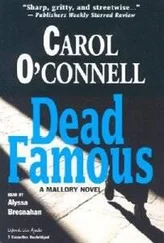Mallory favored tables near the window, and she picked one out, unconcerned that it was occupied. It was only necessary to hover a moment or two before the agents seated there decided that they had eaten enough for one day. And now she sat down alone, another preference, and opened her notebook of landmarks and murder suspects. In the manner of a schoolgirl at her lessons, she bowed her head over the list and crossed off the MidPoint Café.
She was done with her meal when she saw Charles Butler’s Mercedes pull into the lot with Riker at the wheel. He parked it behind her own car on the sidewalk, and FBI agents hurried across the room to hold open the door to the restaurant. This sudden anxiousness to please might be the work of Harry Mars.
Good.
Riker deposited Kronewald’s laptop on the table by her knapsack. “You keep walking off without this thing.”
Mallory never looked up, and her partner melted away, slouching off in search of a cheeseburger. He passed near a corner table perfect for conspiracy, but failed to catch a word of the conversation between the two FBI agents.
Agent Barry Allen was doing his best to talk his partner back onto the right path following the Bureau’s strict chain of command. “You can’t cut Dale Berman off at the legs that way.”
“I needed those results on my soil samples,” said Agent Nahlman. “The bastard never even ordered the tests. I checked with the lab.”
“You can work around it.”
“No, I can’t. It’s an oddball element. Two different kinds of soil in three of those graves-think about it. The perp dug up his kills and reburied them. If I can pinpoint the original burial sites, I can get names and dates- real leads. But Dale Berman doesn’t c are when we wrap this case. What’s one more death to him? He all but offered up Dodie Finn on a plate.”
“That’s cold.”
“And at least a hundred kids are dead. Mallory was right. This case could’ve been wrapped a long time ago. But people keep dying.”
“And that’s Dale’s fault? So now he’s a killer?”
Nahlman sat back in her chair, surprised that this rookie agent was now on a first-name basis with the SAC. “You really like him, don’t you?”
“He’s a great guy,” said Allen. “So promise me this crazy idea just dies right here, right now.”
How absurd was this? A baby-faced boy assuming the mantle of wise man and doling out advice for her own good.
“All right,” she said, lying. “I’m done with it.”
Or was this the truth? She was so tired of breaking her fists on all the barriers Berman had placed in her way. And she had yet to answer Agent Allen’s question. Did she take Dale Berman for a killer? Oh, yes.
In the neutral territory of a center table, Charles Butler had been waylaid by Agent Cadwaller, and he was doing his best to explain to this man why Joe Finn might want to kill him. “Don’t go near the children one more time. Your people have already done too much damage to Dodie.” He put up one hand. “Please don’t deny that. She was just a little girl, severely traumatized, but she was still talking when she went into FBI custody. Not anymore.” Did this come as a surprise to the federal agent?
“The Finns have to leave this road,” said Cadwaller.
Well, now that was interesting. This man was the only member of Berman’s t e am to share in that belief. However, he was arguing a case for federal custody.
“You know that little girl needs counseling,” said the FBI man. “It would help if I could talk to her. Then I could make arrangements for-”
“No!” Charles had estimated Cadwaller’s credentials as something of a joke, and he had tried every polite way to say that a little dangerous knowledge did not a psychologist make. Having failed in that, he decided that good manners were overrated. “Rather than push Dodie into a psychotic break, I suggest you just pull out your gun and blow her little head off. No, really. Shoot her. It’ll set a good example for the others.”
A broadcast reporter and her cameraman passed Cadwaller’s t able in pursuit of Riker, who warded them off with a New Yorker’s o ne-fingered gesture for love and friendship. And now the detective joined Dr. Magritte, pulling up a chair at the old man’s t able. He wasted no time with pleasantries.
“Okay, Doc, we’re hunting a nutcase and you’re leading a parade of ’em. You gotta have a few favorites who aren’t covered with doctor-patient confidentiality. You said these people came from a lot of different therapy groups.” With a nod, he gestured to the Pattern Man’s t able. Horace Kayhill was sitting alone with his spread maps. “Horace keeps coming back to the caravan. He likes being close to you, doesn’t he? This trip must be nutcase heaven-a doctor who can’t get away from his patients.”
Dr. Magritte gave up a smile of apology and a wave of the hand to say that Riker would get nothing helpful from him, not even the admission that Horace Kayhill was his patient.
Riker watched the doctor’s face, hoping to see something useful there if he should hit upon the right question. “You know who the killer is, don’t you? Do you talk to this freak on the phone? Are you Internet pen pals or what?”
And now the doctor, somewhat surprised, said, “You and your partner don’t communicate very well. I bet you’re wondering how I know that.” He smiled. “Your cheeseburger is getting cold, Detective.”
Special Agent Dale Berman was basking in camera light and sharing a table with a celebrity anchorwoman. This prime-time personality seemed disappointed in his basic profile for a serial killer. She pulled back the microphone to say, “Isn’t t hat sexist? Why not a woman suspect?”
“It was a man.” Dale Berman wore his mask of tragedy today, but only while the camera was on him. “A female serial killer is very rare.”
The newswoman extended her microphone to the next table occupied by the wonderfully photogenic cop from New York City. “What do you say, Detective Mallory? Could a female have done all those murders?”
The detective never looked up from her laptop computer. “Female killers are as common as dust.”
Dale Berman’s face fell.
“Like that prostitute who killed her customers?” The newswoman’s professional smile was waning as she waited for a response. Precious airtime was slipping by. “And then we’ve got mothers killing their own children.” She gave Detective Mallory a smile of encouragement. When was this young cop going to open her damned mouth? The reporter filled in the silence with, “Nurses killing patients? Oh, and the black widows-wives killing husbands for insurance money.”
“I like money motives.” Detective Mallory looked up, finally hearing something of interest to her, but she was facing Dale Berman, not the camera.
The cameraman stood before Mallory’s t able, bowing low, hoping for eye contact, and the reporter said, “So, Detective, you think a woman could be-”
“It was a man,” said Mallory, who had now engaged Agent Berman in a staring match. “Men are monument builders. That’s what the killer’s done with this road.”
“That’s right !” And with these words, Dale Berman had recaptured the cameraman’s attention and the lens. “The killer believes these murders will make him live forever in the-”
“And what do you think, Detective?” asked the reporter as her cameraman swung around to refocus on the New York City blonde.
“Nobody lives forever,” said Mallory to Dale Berman.
At a far remove from Dale Berman and the reporter, Mallory found another empty chair by the window and sat down with the Pattern Man, who promptly spilled his coffee. As she arranged her knapsack and the computer on top of his maps, she had to endure his apologies for clumsiness and listen to the day’s figures for the amount of caffeine ingested by way of coffee and cola. He did not seem to mind that she never spoke to him; the little man was more comfortable talking at her rather than to her. Horace Kayhill unfolded another map so he could describe the new landmarks discovered since his last trip down Route 66. “The road is always changing, you know, just like a living organism.”
Читать дальше












